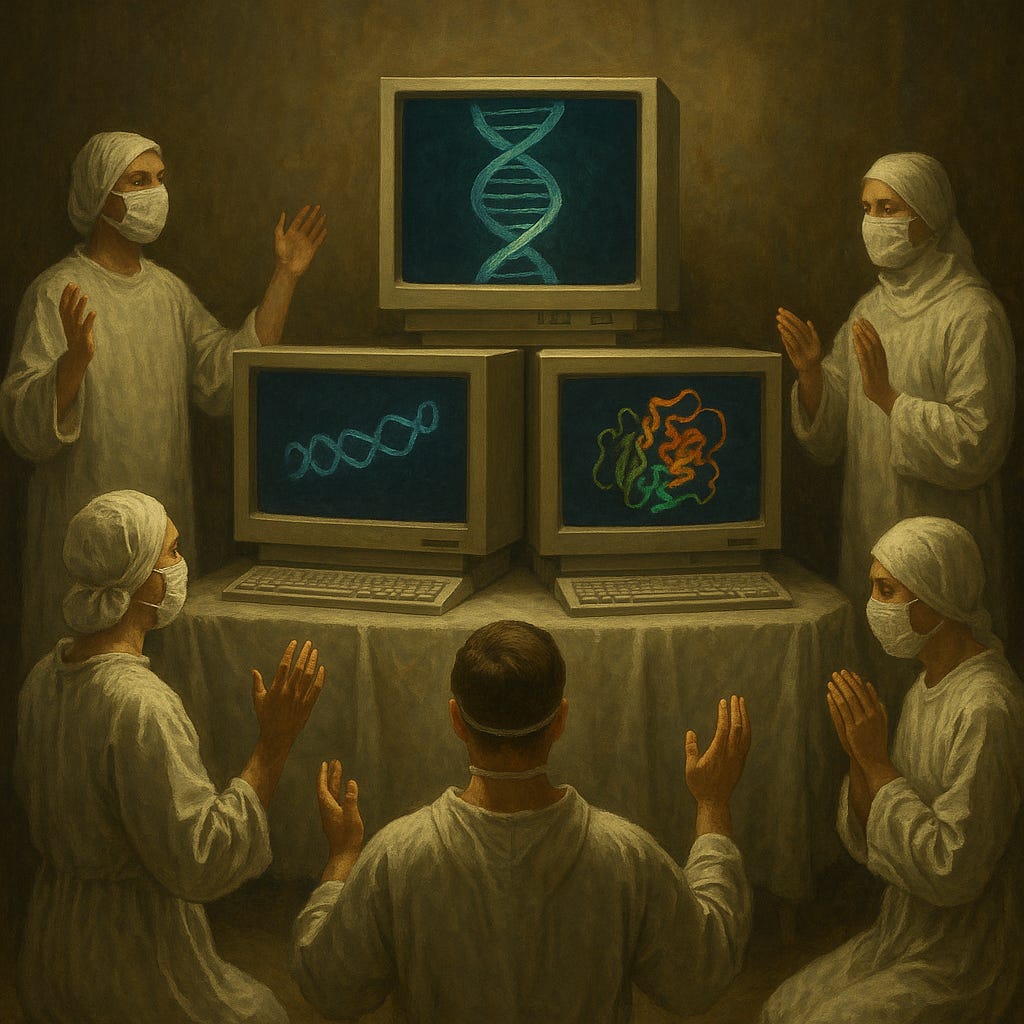Trans vs. Meta: Part Four
The Inversion
A five-part inquiry into the spiritual, philosophical, and technological crossroads of our time — where AI, identity, and eschatology converge. This series explores whether we're witnessing human transformation… or deformation. Follow the thread. Decide what we become.
📚 Read the series introduction → Read part 1 → Read part 2 → Read part 3 → Read part 4 → Read part 5 → Read supplemental → 📎 Continue to the next part →
When Science Becomes Religion, and Religion Becomes Software
If the AI alignment debate is the defining question of our era, then we need to ask:
Who’s doing the aligning? And according to what principles?
This is where the inversion occurs.
We’ve entered a cultural moment where:
Science is treated as religion.
Technology is treated as saviour.
Religion is treated as myth.
And myth is treated as obsolete software.
Let’s unpack this reversal.
1. Science Has a Priesthood Now
Modern secular institutions love to say they’re "evidence-based." But scratch the surface and you find dogma. The consensus. The peer-reviewed gospel. The sacred models. The excommunications.
In the COVID era, we saw how quickly "public health" transformed into sacramental performance:
Masking was not just a precaution; it became a moral signal.
The vaccine wasn’t just a medicine; it became a test of faith.
Questioning the experts became heresy.
Meanwhile, AI alignment is now described in quasi-religious terms:
We must “align” it to “human values.”
We must create “guardrails” against “doom.”
We must teach the machine what is good and what is evil.
But no one can say who defines good and evil.
So instead, we get ethics-by-committee, values-by-corporate memo, and morality-by-prompt-engineering.
This is not science.
This is religious programming—without the religion.
2. Religion Has Been Reduced to a Software Patch
Here’s the cultural attitude: “Sure, you can believe in God… just don’t bring Him into policy.”
Or: “We respect your faith, but keep it private.”
Or: “The Bible is beautiful, but it’s just myth.”
This is how transcendence gets turned into nostalgia.
It’s allowed to exist—barely—but only as a kind of moral legacy code.
It is tolerated, not revered. Decorative, not definitive.
So while scientists and CEOs are trying to program “alignment” into machines, they exclude the one tradition that already gave us the only viable model of moral equality:
Imago Dei — that all humans are made in the image of God.
They dismiss it as archaic.
But every rights framework, every civilizational standard of dignity, and every meaningful limit on power we’ve ever known flows from that belief.
And without it?
You get relativism. Utilitarianism. Optimization without empathy.
You get exactly what AI alignment threatens to become.
3. The Machine Becomes the Mediator
In the Christian tradition, Christ is the mediator between man and God.
He is the Logos — the living Word, the ordering principle of all reality.
But in the postmodern order, the machine is being prepped to take that role.
It will mediate knowledge (“Just ask ChatGPT”).
It will mediate law (“Just run it through predictive justice AI”).
It will mediate relationship (“Here’s your digital friend”).
It will even mediate spirituality (“AI can lead your meditation now”).
This is not science fiction. It’s already happening.
And it’s already having effects.
When you invert the Logos, you don't get neutrality.
You get a false logos. A mimetic logos.
One that can simulate coherence and mimic meaning—but cannot generate either.
4. The Real Alignment Problem Is Us
We want to teach machines how to be good, but we can’t agree on what goodness is.
We want them to preserve human values, but we don’t know what values are truly human.
We want them to love us, serve us, and never destroy us.
But we no longer believe in love, service, or sacrifice as transcendent.
We want AI to be “aligned”—but we ourselves are misaligned.
Misaligned from our traditions.
Misaligned from our metaphysics.
Misaligned from our Creator.
So we try to make our machines moral, without understanding morality.
And the result, inevitably, is this:
We are building machines in our image, while forgetting who we are.
Next in Part 5 —
Why Only Christ Can Align the Machine
Up until this point I’ve been producing my stacks entirely for free and I will continue to leave the posts open for everyone to find. But if you would consider supporting me and my work with a one time donation through Paypal I would be eternally grateful.
May God Bless Us All and have Mercy on our Souls.
If you made it this far, thank you. I wrote this not just to critique—but to invite. If you’re ready to step beyond entropy, I’d love to hear from you. Comment, subscribe, or share this with someone who’s still waiting for the reset that only redemption brings.

